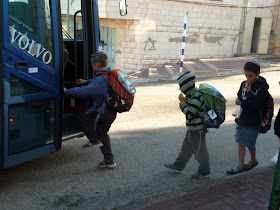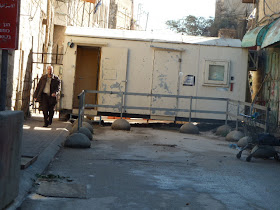 |
| Clock tower in Bab As-Zawiya, near entrance to the souk (market) |
I'm back in Hebron, which I described in my blog of Wednesday, October 31. This morning I monitored Gilberto Checkpoint (just a telephone-booth size cubicle with one soldier who had no interaction with the passersby). I was pleasantly surprised to see 260 Palestinian children walk down the hill to go to school, not harassed at all by the Jewish settler children. Some of the Jewish children had a school bus. I didn't see any violence on the kids' return from school, either.
 |
| Palestinian children unmolested on the way to school |
 |
Israeli children board their school bus
|
 |
| Checkpoint 56 |
At the bottom of the hill stood this larger checkpoint through which the Palestinian students had to walk. On the other side (the H-2 area under Israeli military control) there were half a dozen soldiers and a couple of observers from the Temporary International Presence in Hebron (TIPH), which despite its name has been in place for over 15 years.
 |
| Shuttered stores on Shuhada Street |
As a foreigner, I was able to stroll down Shuhada Street, past the museum where we were briefed by the spokesman for the Jewish community on October 31. Israel closed all the stores after the first Intifada for security reasons, and prohibits Palestinians from the street, even those whose houses used to have doors on it. It was eerily quiet, with no people except for a few soldiers. A sign posted to justify the closures said "Large, thriving commercial and shopping centers, off-limits to Jews, are open in the Arab part of the city."
 |
| Closed door with concertina wire on Shuhada Street |
 |
| Jewish mural on Shahada Street |
The Jewish community placed four large murals along Shuhada Street to remember periods of their history in Hebron. The one on the left refers to a period when, according to the Jewish narrative, the community was characterized by "Torah, charity, and kindness." Too bad that does not carry over to the 21st century, when they dump garbage on the Palestinians below to make their life miserable.
I visited an organization that is working to make their life better: the Hebron Rehabilitation Committee (HRC), funded by the Palestinian Authority and European governments and NGOs. It seeks to preserve the city's cultural heritage, to encircle Jewish settlements to stop their expansion, to revive the old city by rehabilitating the infrastructure, and to help residents with health, education, entertainment, and social and financial aid. The Committee says that Israel's army prevented reconstruction in certain areas of the old city and buildings near settlements. Palestinian families who sought to live in those houses were arrested.
 |
| Building being rehabilitated as a community center |
Nevertheless, the HRC has been able to restore more than 900 buildings in the old city, according to spokesman Anas Maraqa. He is proud of the year-round program of classes in the academy funded by Spain. They offer training in home improvement, carpentry, masonry, computers, and other subjects. He says the HRC also has a legal program that encompasses disputes between Palestinians and Israelis. "Our dream is to reopen Shuhada Street," says Anas, but he doesn't seem to expect that to happen any time soon.
Here are two photos that illustrate the contrasts I found in Hebron: a horse-drawn fruit cart not far from an upscale five-story atrium mall with escalators and glass elevators that would put many U,S, malls to shame.










No comments:
Post a Comment